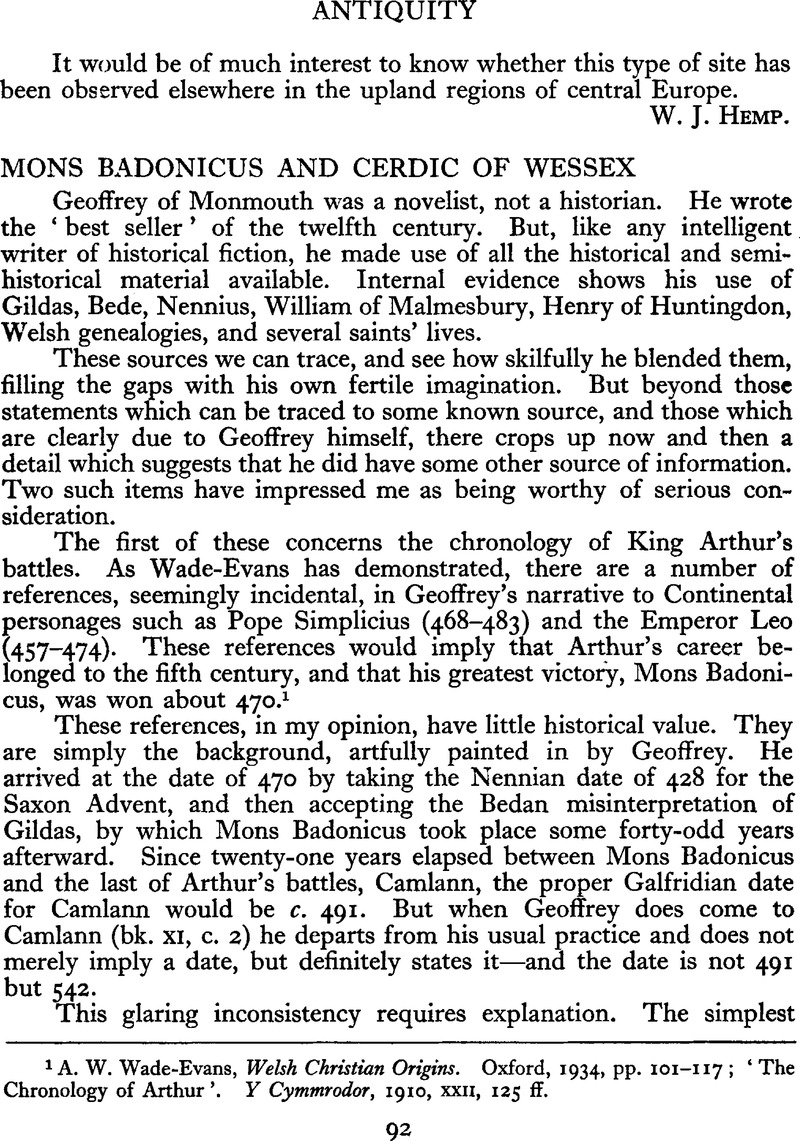No CrossRef data available.
Article contents
Mons Badonicus and Cerdic of Wessex
Published online by Cambridge University Press: 26 May 2015
Abstract

- Type
- Notes and News
- Information
- Copyright
- Copyright © Antiquity Publications Ltd 1939
References
1 Wade-Evans, A.W. Welsh Christian Origins. Oxford, 1934, pp. 101–117;Google Scholar ‘The Chronology of Arthur’. Y Cymmrodor, 1910, 22, 125 ff.Google Scholar
2 Edited by Labbe, Nova Bibliotheca Manuscriptorum Librorum. Paris, 1, 349.Google Scholar The ‘Chronicle’ itself is Avranches Library MS. 213. It is reprinted by Migne Patrol. Lat., CCII, 1323.
The relevant passage runs:
CCCCXXI. Natus est S. Gildas. His diebus fuit Artus Rex Britannorum fortis, & facetus.
Of course CCCCXXI is 421, not 521. But the date intended is 521, as demonstrated by a later entry:
DXXXIV. Occisus est Cauallonus Rex fortissimus majoris Britanniae.
Ca(d)uallonus is unquestionably Cadwallon ab Cadfan of Gwynedd, who was defeated and killed by Oswald of Bernicia in 634.
3 I follow the interpretation given by , H.M. and Chadwick, N.K. The Growth of Literature. Cambridge, 1932, vol. 1, p. 147, note I.Google ScholarPubMed
4 Nennius, c. 66. It is worth noting that this is followed by an attempt to calculate the date of an apparently unspecified event, which seems to be 71 years later.
5 Fletcher, R.H. ‘Arthurian Material in the Chronicles’. (Harvard University) Studies and Notes in Philology and Literature, 10, 1906, p. 185.Google Scholar
Snell, F.J. King Arthur’s Country. 1926, p. 106.Google Scholar
6 Crawford, O.G.S. ‘Cerdic and the Cloven Way’. ANTIQUITY, 1931 5, 441 ff.Google Scholar
7 MSS. Tiberius B.I. & A. VI.
8 J. Kemble, Codex Diplomatics Aevi Saxonici, No. 1077.[Also Birch, Cart. Sax. 2, 594.Google Scholar For an attempted identification of these bounds see my Andover District (Oxford, 1922), pp. 69–72.Google ScholarPubMed Unfortunately the early part of these bounds is very difficult; but it seems certain that Ceardices beorg lay somewhere not far west of the junction between the Hurstbourne and the Test, perhaps in the neighbourhood of Faulkner’s Down. Major Allen has searched this locality from the air without finding any signs of unknown barrows. O.G.S.C]
9 Alfred, Anscombe‘Indexes to Old-Welsh Genealogies’. Zeitschrift für Celtische Philologie, 2, 1904.Google Scholar


